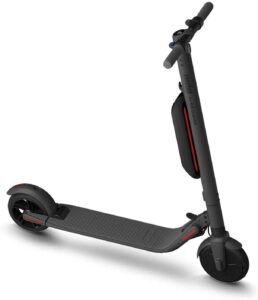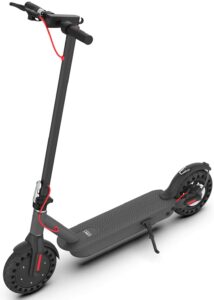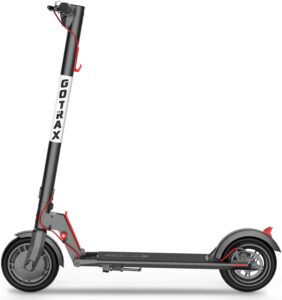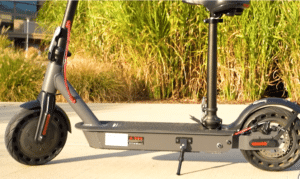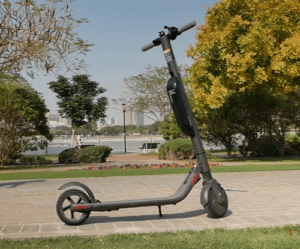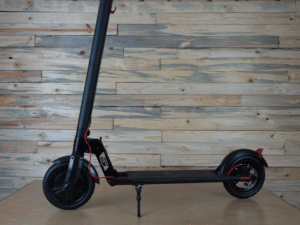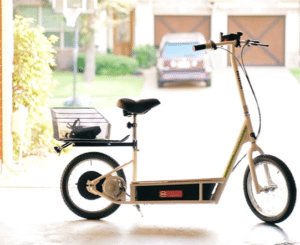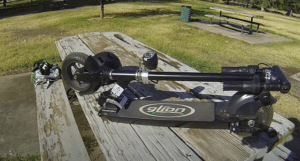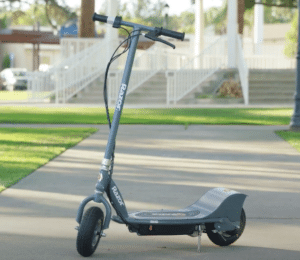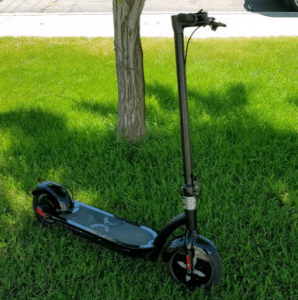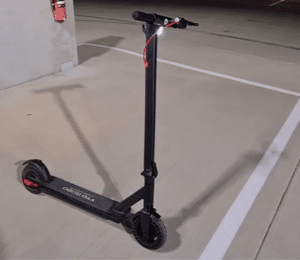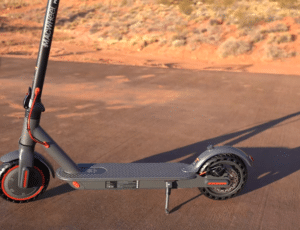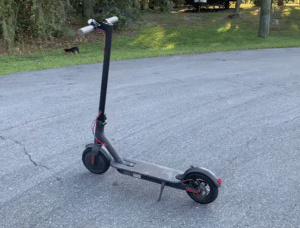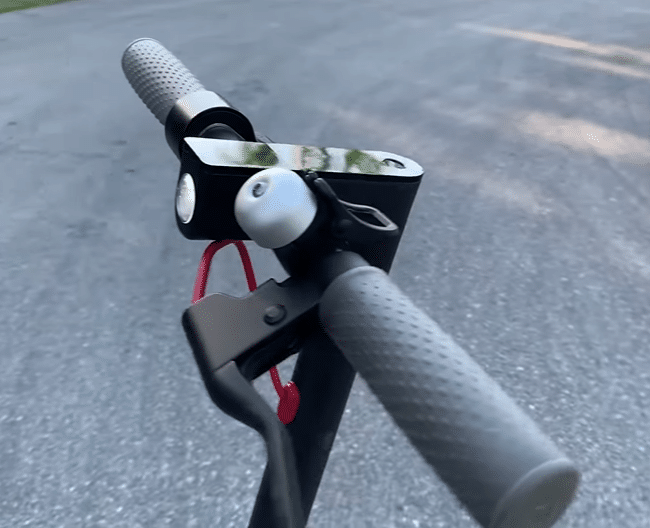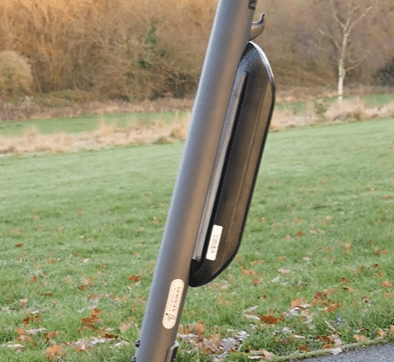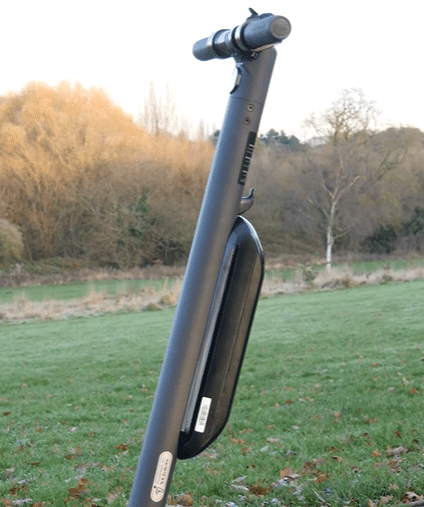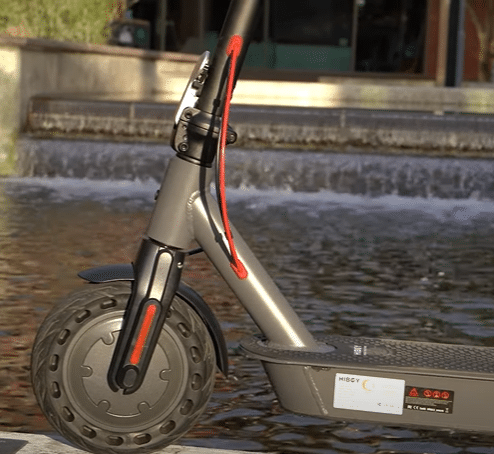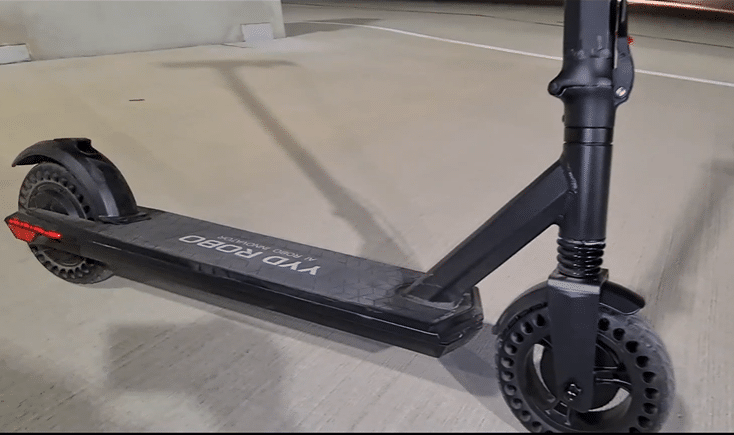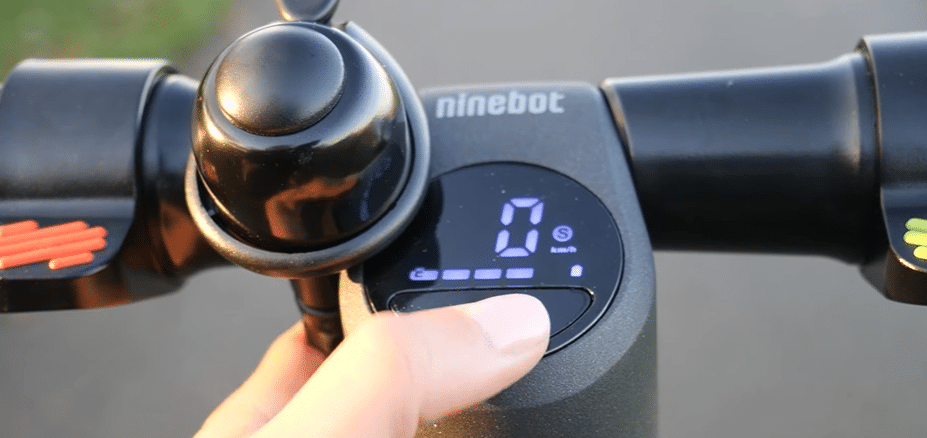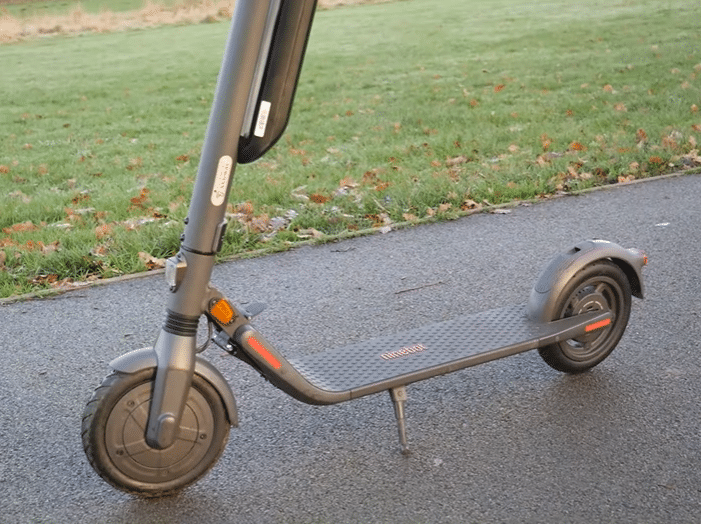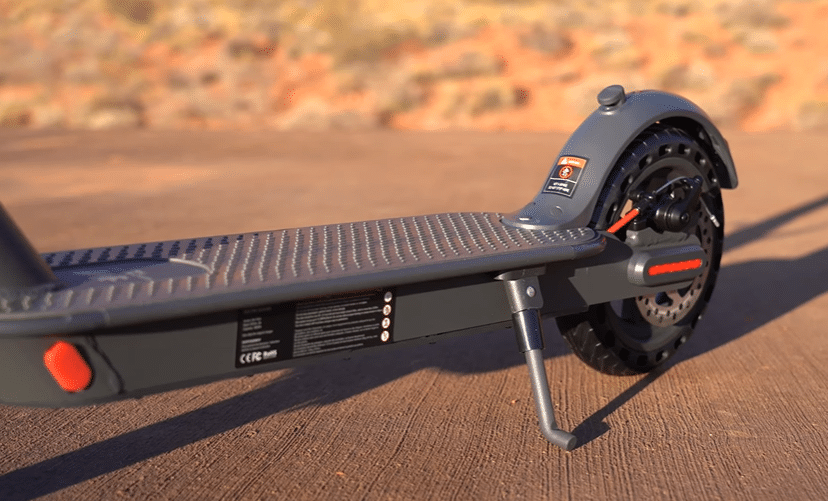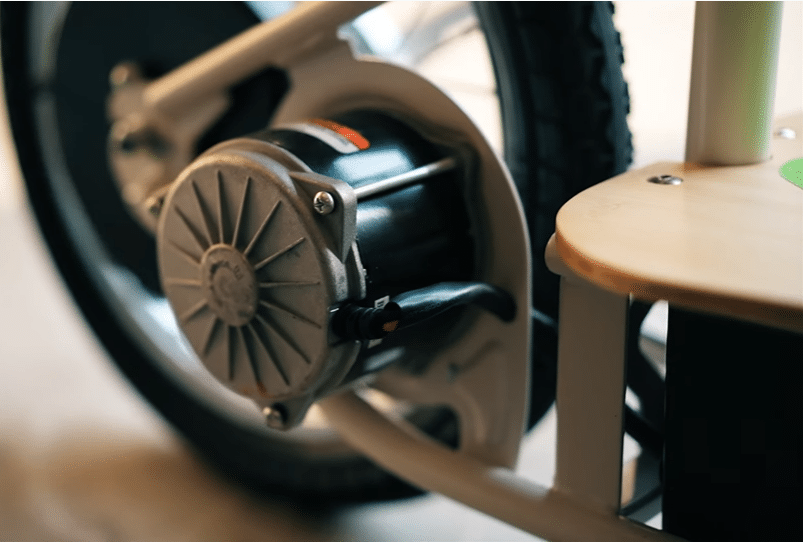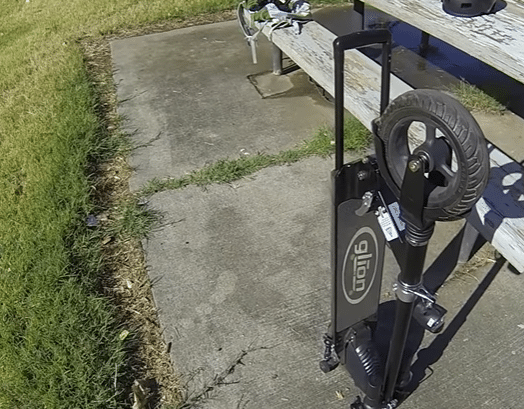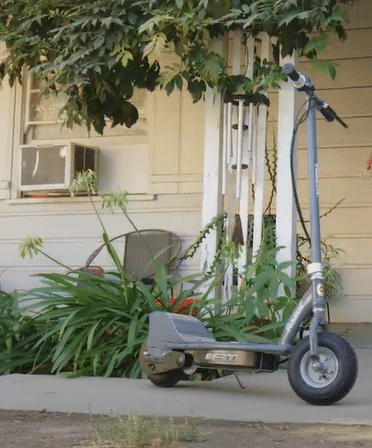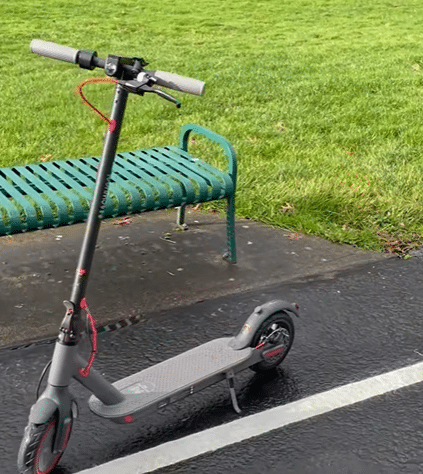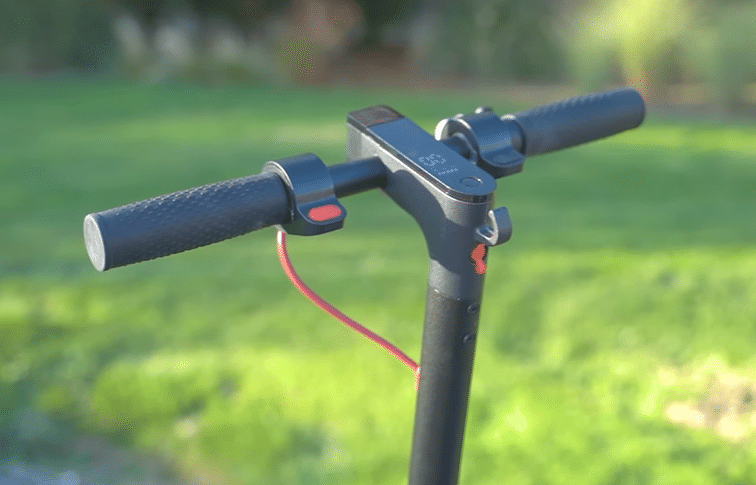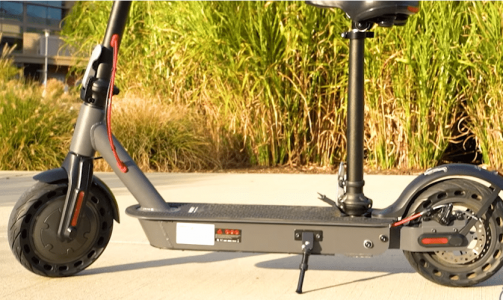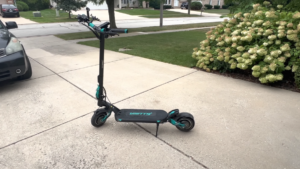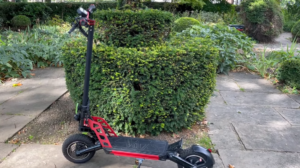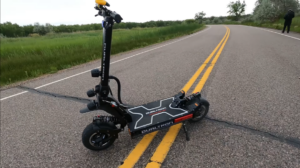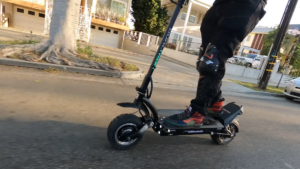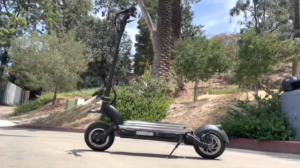-
Lucas Travis
- October 8, 2022
With the advent of technology, regular commute is made easy by switching to alternative means of transportation. A commuter scooter is perfect for urban terrains where people are dense, and traffic is likely. To avoid regret in shelling out a couple of bucks, our experts have devised this guide of the best electric scooters for commuting to ensure that you are getting your money’s worth.
- 800W motor power
- Dual anti-lock brakes
- Shock and vibration-proof
- Dual batteries
- Lightweight and portable
Electric Scooter
- Powerful motor
- Top speed of 19mph
- Longer range
- Digital lock
- Dual braking mechanism
- Highly affordable
- Dual braking mechanism
- Large, air-filled tires
- Foldable
- Commendable specs
Reviews of the Best Electric Scooters for Commuting
Hiboy S2 Pro Electric Scooter
The S2 is Hiboy’s flagship line packed with an improved battery capacity and longer range than most commuter scooters. Its 10-inch solid tires complement the rear dual spring suspension, guaranteeing a smooth ride. It also has an IP54 resistance rating, cruise control, integrated mobile app, optional seat slot, among others.
The S2 Pro has a weight limit of 220 lbs, and a top speed of 19mph under optimum conditions. It is on par with other performance models at a range of 25.6 miles. For riders seeking to commute in urban spaces, the Hiboy S2 Pro is able to cater to their needs with its versatile specs and durable build.
Pros
- 500W brushless hub motor
- Top speed of 19mph
- Longer range of 25.6 miles on a single charge
- Integrated LED display
- Has a digital lock to bolster security
- Rear dual shock absorption mechanism
- Disc brake and eABS regenerative brake
Cons
- Heavier than similar e-scooters
- Falls short on off-road terrains
Segway Ninebot ES4 Electric Kick Scooter
When making a shift from bigger vehicles to an eco-friendly commute such as an electric scooter, one would surely prefer to have a durable model. The Segway Ninebot ES4 has dual batteries up to 800W, a top speed of 19mph that can travel up to 28miles, and a maximum weight limit of 220 lbs.
The ES4 is a powerful commuter scooter that can offer heavy-duty performance, yet still be lightweight and portable. It weighs 30lbs and has a one step folding mechanism that allows you to easily store and use it for later. It also has a front and rear shock absorbers, and mechanical and electric anti-lock brakes.
Pros
- 800W motor power
- Top speed of 19mph on a 28mi range
- Dual anti-lock brakes
- Front and rear shock absorption capacity
- Dual batteries for optimum performance
- Lightweight and portable
- Longer range
Cons
- Quite pricey
- Charging the batteries take a while
Gotrax GXL V2 Commuting Electric Scooter
The Gotrax GXL V2 is an exceptional entry-level scooter with great value for its price. For under $300, it has a top speed of 15.5mph and a range of 12 miles on a single charge depending on the rider’s weight. Its 250W motor also has a gradual acceleration feature and hill-climbing capacity of 14 degrees. The V2 also has two riding modes that help regulate speed, which is beneficial especially for beginners.
Additionally, it also has a dual-braking system to make sure traffic injuries are avoided. The rear disc brake and regenerative electric brakes are integrated to provide a smooth stop even when riding at this scooter’s maximum speed.
Also check the complete review of GoTrax GXL V2 scooter here.
Pros
- Highly affordable electric scooter
- 250W motor power with a top speed of 15.5 MPH
- Dual braking system
- Digital LED display
- 8.5” air-filled tires
- Front and rear brake
- One-step folding mechanism
Cons
- Not recommended for heavier riders
- No rear lights
Razor EcoSmart Metro Electric Scooter
One of the primary concerns of the skeptics is the scooter’s ability to carry a load. With the Razor EcoSmart Metro E-scooter, this is no longer a problem as it comes with a cargo carrier, and even a comfortable seat to accompany you in your commute. It has a wide bamboo deck that allows plenty of foot room, and a cushy, soft-padded seat to ensure a comfortable ride.
As for its specs, it has a fast and powerful hub-driven motor that delivers a quiet, high-torque engine that can take you places at a max speed of 15.5mph with ease and efficiency.
Pros
- Soft-padded seat and wide bamboo deck
- 16-inch air-filled tires
- Has a cargo carrier for extra baggage
- High torque hub-driven motor
- Tubular steel frame build
- Ergonomic and eco-friendly design
- Front and rear lights
Cons
- Heavy build, not portable
- Battery life can be improved
Glion Dolly Foldable Lightweight Adult Electric Scooter
If you are in need of an affordable scooter that can give you a smooth ride around town, then Glion Dolly is a great option for you. The Glion Dolly is lightweight and foldable, making it the perfect companion on your commute. Its 238Wh battery has a max speed of 15mph and can go up to 15 miles on a single charge with a maximum rider weight of 255 lbs.
Additionally, with its puncture-free honeycomb wheels you would not have to worry about flat tires. As for its design, the Glion e-scooter has a patented dolly and vertical self-standing that allows easier storage and better portability compared to other scooters.
Pros
- Ergonomic folding mechanism
- Aircraft-grade build
- Longer range
- Non-puncture solid tires
- Anti-lock brake
- Front and rear suspension
- Lightweight and portable
- Good value for its price
Cons
- Inferior shock absorption ability
- Underwhelming uphill climb capacity
Razor E300 Electric Scooter
The E300 is among Razor’s budget models that can truly give you a good value for their price. It has a wide deck and durable frame that allows a weight limit of 220 pounds. With its 250W high-torque, ultra-quiet single speed chain-driven motor, it has a maximum speed of up to 15mph.
If you are looking for a commuter scooter that requires little to no effort in starting up and riding off, the Razor E300 is perfect for you. It is recommended for teens and adults alike, and has lots of user-friendly inclusions like a retractable kickstand, a hand-operated front brake, and extra 10-inch pneumatic tires.
Pros
- Super-sized deck and frame
- High torque, chain-driven motor
- Features an all-steel frame
- Large pneumatic tires
- Handy twist-grip thumb throttle
- Affordable price
Cons
- Shorter range than similar scooters
- Not foldable
Hover-1 Alpha Electric Kick Scooter
The Hover-1 is known to manufacture budget scooters, and the Alpha Electric Scooter is one of it’s most prime lines. With a 450W brushless motor that can reach top speeds of up to 17.4 mph and a weight limit of 264 lbs, a comfortable ride around point A to point B is guaranteed.
As for its build, this affordable electric scooter has pneumatic front and rear wheels which can sustain most shock and vibration during your trips. The deck of Hover-1 Alpha Electric Kick is wide enough to allow comfortable foot space, and is even foldable to encourage portability.
Pros
- 450W brushless motor
- 10-inch air-filled tires
- Longer range
- UL-certified lithium ion battery pack
- Integrated LED headlight
- Foldable
- Built-in bluetooth speaker
- Rear drum brake
Cons
- Shorter range than other scooters
- After sales service can be improved
YYD ROBO 350W Electric Kick Scooter
If you are looking for an affordable commuter scooter that is always on the go, the YYD ROBO Electric Scooter may be right for you. It has an easy-fold standard, and the ability to boot up with ease in less than 10 seconds. One can always bring it anywhere including public transportation, or store it in a car effortlessly.
It has a powerful brushless motor that can reach varying top speeds averaging to 19mph depending on riding conditions. It also has a responsive panel that can easily be hooked up to your phone or gadget, which allows optimum cruise control.
Pros
- 350W Brushless Motor
- Maximum speed of 19mph
- Optimum cruise control
- App control technology
- Ultra bright headlights
- Double braking system
- Quick folding design
- Reliable front and rear wheel features
Cons
- Quite heavy
- Handlebars are not flexible
Macwheel MX PRO Electric Scooter
The Macwheel MX Pro is an ideal commuter scooter with its versatile and powerful 350W brushless motor that can handle most urban landscapes and the terrain changes that go with it. Its high-capacity lithium ion battery allows you to travel with complete cruise control while giving you a distance of up to 25mph under optimum conditions. It comes with 3-riding gears and a LED display for easy use.
This adult electric scooter is refined for narrow alleys and dense traffic making it the perfect companion for runs around the city. Additionally, its lightweight and folding mechanism makes it highly convenient to carry around public transport or store in limited spaces.
Pros
- 350W brushless motor
- 8.5” non-pneumatic tires
- Integrated LED display
- Bright front and rear light features
- Rear disc braking system
- Longer range travel capacity
Cons
- Product handling can be improved
- Some specifications may be overstated
Xiaomi Mi Electric Scooter
Xiaomi might be known for their smartphone and other electronic gadgets, but they also have their own electric scooter line. The Mi Electric Scooter has a sleek, portable design that can easily be paired with a bluetooth, and synced with your mobile gadgets. Its aerospace-grade aluminum black frame has a 500W motor that can travel up to 15mph at an 18.6miles range.
The Mi Electric Scooter not only has advanced, state of the art technology, it also has added layers of protection such as short circuit and under-voltage covers, LED notification lights, and an IP54 rating, among many others, to ensure that it is always on the go.
Pros
- Sleek, portable design
- Aerospace-grade aluminum frame
- 500W motor with decent range
- Top speed of 15mph
- Longer range
- Reliable front and rear wheel protection
- Smart app that can sync with gadgets
- Certified IP54 rating
Cons
- Does not go well with additional weight
- Handlebars are small
Electric Scooter for Commuting Buyer’s Guide
Design and Build
The first thing most buyers notice is the scooter’s design. Chances are, they would be partial to scooters that pass their personal aesthetic and practical preferences.
If you wish to acquire an e-scooter that is portable so you can take it wherever you go, you might opt for a model that is ergonomical and has a compact size. On the other hand, if you wish to have a fast, powerful scooter for off-terrain and nature trips, then it is best to look for one with a bigger, more durable build.
Nonetheless, for an all-around comfortable ride, it is best to look for a model that can sustain shocks and vibrations that you will definitely encounter along the way. A scooter with a dual suspension, for example, can make your riding mode more comfortable as it helps alleviate sudden stops and vibrations.
Our experts also suggest looking into the tires and motor position, and see which fits you better: Is it front or rear wheel drive? A front wheel drive is usually lighter and more economical; while rear wheel drive provides better weight shifting and riding mode. Dual wheel drives are also an option—this can give you longer range and better cruise control when riding.
As much as one is compelled with a commuter scooter’s overall aesthetics, other factors like weight distribution, battery placement, and deck width also play an important role in the general riding experience.
For instance, is the scooter’s battery placed in the front area to minimize weight? Does it balance well with the scooter’s front and rear wheel? If so, while this can make it more compact, it could also make it front heavy and cause the deck to shift up if you go on faster speeds.
Our team of scooter enthusiasts recommend having the battery placed under the deck so it does not get in the way of your foot space. It is best to see if the overall design balances and complements the scooter’s performance. Every placement should make sense, and help the rider use the vehicle to its fullest potential.
Motor Power
The motor power of your commuter scooter can easily determine how fast and how frequent you can use it. This will also be the main factor to consider on which type of scooter to get when making a purchase. If you need something fast, you would need a motor powerful enough to cater to your needs. If you need something heavy duty, then it will also be dependent on the motor power and the overall build of the vehicle.
A motor power is given in the unit of watts. A watt is equivalent to joules per second or energy per second. In simple terms, the higher the watts, the more powerful the motor.
Generally, utility or commuter scooters are cheaper because they would be used in urban spaces, meaning they would usually require a less powerful motor to operate. However, if you are thinking of using it to carry heavy loads, you might have to recalibrate your options to make sure it can accommodate your needs.
It is important to note that commuter scooters with lesser motor power would generally be cheaper, while high-end ones are more expensive. Our experts strongly suggest that you weigh your options and make sure you are opting for a practical, sound decision when making the purchase.
The usual types of motor for commuter scooters are brushed direct current (DC), and brushless DC electric motors.
Brushed motors have been around longer, and are the traditional option for smaller vehicles. This operates by having mechanical brushes drag along the interior of the motor as it alternatively powers different coil phases. Its downside, however, is it causes the brushes to wear down in time because of friction, which can in turn cause the voltage to act irregularly.
The brushless direct current (BLDC) motors or EC motors are developed in the 1970s and are built to be the more durable, efficient variety. They are also quieter and less likely to cause friction which can lead to overheating. For brushless motors, the mechanical component is converted to a digital switching circuitry that allows it to power different coil phases.
Battery
If you have a brand new commuter scooter that you decide to use for your trip, it is a major deal breaker if it decides to give up on you half-way. If an e-scooter suddenly powers down and stops, the battery is almost always the culprit behind.
Thus, our team recommends knowing which battery your commuter scooter runs on and its capacity to avoid unnecessary hassle in the long run. It is also helpful to read feedback and reviews of other people to check if the battery can hold up to its promise, and it is not an oversell.
The one thing in common for the best electric scooters for commuting is their reliable battery quality. For quality and safety purposes, ratings such as IEC and UL [1] are standardized to determine a battery’s capacity and what it should be used for.
Our experts suggest setting a realistic range and frequency that you will be able to use your commuter scooter for. If you plan to use it daily for commuting or cruising, take that into consideration when making a purchase to ensure that your battery can handle such a task.
You can also maximize the battery life by not overloading the scooter. Heavier load and exceeding the scooter’s weight limit means more power exerted by the motor, which in turn drains the battery. You can reach a longer range by travelling light so you can maximize the battery’s potential.
For some models, a removable battery pack is an option. This means that one can replace the battery entirely when it has reached its limit. If you think you will be using your commuter scooter regularly, our experts suggest you consider this option.
Speed
Depending on the ride quality you wish to achieve during your e-scooter trip, speed is crucial. It is vital to note the maximum cruising speed and the comfortable driving speed when purchasing your own commuter scooter.
Some advanced riders crave faster speed to give them an exhilarating feeling. If you are one of such, you would have to invest more as e-scooters who are able to deliver would cost more because of its build and specs to boost the range.
If you are a casual rider, it is best to get one with a comfortable cruising speed to meet your needs, as riding the e-scooter continually at its top speed can compromise its performance in the long run.
The average scooter ranges from 15 to 18 miles per hour. Scooters designed for kids can go as slow as 7.5mph, while scooters designed for more seasoned riders have a top speed as fast as 50mph.
The legal speed limit for e-scooters varies in every state, but the usual street-legal requirement is around 15mph, give or take. Most manufacturers build around this top speed for scooters in compliance with legal requirements.
(For 50cc scooters, here is the speed a 50cc scooter can go)
Weight Capacity
It is important to note that not all scooters are designed to carry the same load. Depending on their specifications, some can accommodate heavy loads, while others are only fit to carry an average rider.
For instance, scooters designed in Europe have a higher tolerance for weight as the average rider in the area weighs at around 100kg. Meanwhile, those in Asia have lower weight limits since the average rider weight in the area has a smaller build/frame.
That said, our experts strongly recommend taking your commuter scooter’s weight limit into consideration before making a purchase. It is best to choose one that exceeds your weight so it can tolerate an extra should you have a load to carry with you.
If you are riding a commuter scooter that is not compatible with your weight, there is a high risk that its performance will be compromised. In worst case scenarios, this can cause injury during the trips.
Most electric scooters can accommodate an average of 120kg or 265lbs weight load.
Tires and Suspension
The best electric scooters for commuting are those that will not let you down in crucial times. The tire type, its diameter and width, as well as its tread pattern contribute to your commuter scooter’s safety, traction, and general ride quality.
As a rule of thumb, larger wheels can provide you with a better cushion on rocky, uneven roads. These fat, treaded tires can help with the scooter’s suspension especially in off-road rides.
Some scooter models have wheels that are knobby and preferable on off-road treads, while some have a smooth-patterned tread that is ideal for paved roads. Most commuter scooters will come with smooth, on-road tires fit for urban scapes; while many premium and extreme performance scooters come with large, coarse-patterned treads for off-road adventures.
The two usual types of scooter tires are solid or puncture-free tires, and pneumatic or air-filled tires.
Pneumatic or air-filled wheels can do better with shock and vibration absorption. It may be air-filled, but it is easier to maintain in case it gets punctured. Our experts suggest applying a puncture-protection fluid before the initial ride to add a layer of protection on the tires.
On the other hand, solid, rubber tires are airless so they are, in essence, puncture free. This means you would not have to worry about flat tires. These airless tires have a tolerance for things one usually encounters on the road including glass, thorns, or nails. They are fit-and-forget, and require less maintenance overall. However, it is still subject to being worn out, so it might also need replacing in the long run. It is also not as shock and vibration-proof compared to pneumatic tires.
Delving further, suspension in simple terms is the force smoothing out bumps and cracks from uneven surfaces so you would not have to feel or lose balance over it. This is a key factor for your scooter ride especially if you are considering going off-road.
Suspension can either be attached in the front or rear wheel of your scooter to guarantee it gives you a safe, comfortable riding experience.
To complement your scooter’s suspension capacity, brakes are also crucial. For starters, there are 3 main types of brakes usually used on your typical electric scooters: electric/regenerative brake, front or rear disc brake and/or rear drum brake, and foot brake.
Electric or regenerative brakes are generally low maintenance, but are less effective in quick and sudden stops. If you wish to travel faster than 15mph and need to suddenly stop, these brakes are known to be the least effective.
Disc brakes have the most powerful stopping capacity and are lighter than drum brakes. This lightens the overall load and allows extra speed. It can either be attached as a front disc brake or a rear wheel disc brake.
Meanwhile, drum brakes are usually enclosed inside the wheel hub. Like electric brakes, they are also low maintenance. Additionally, they perform consistently well even in moist to wet conditions.
Disc and drum brakes usually excel the most out of the brake options. However, they have a tendency to wear out over time, and would have to be serviced or altogether replaced.
The third and last brake variety are foot brakes. They are activated by pushing your foot down the rear mudguard. This takes some time to master, and is only often used as a backup brake option. Foot brakes may have a reliable stopping power, but they are not as comfortable or efficient to use as drum or disc brakes.
Some models have multiple braking systems to ensure the safety and comfort of the rider.
Weight and Portability
Commuter scooters are usually portable and lightweight e-scooter models to allow ease of transportation. As it is commonly used in urban spaces, it usually has a small frame that makes it convenient for the rider to carry and store wherever. Some models are also foldable, making it ideal for those who have limited storage space at home.
As you would need to bring along your scooter from the start to end of your trip, it is important to take note of its weight into consideration to avoid fatigue. Some models also go with foldable handlebars, and even a scooter bag to increase portability.
Like we have previously mentioned, our experts strongly suggest taking into account the main purpose of your scooter. If it is meant to be brought all around town, it is best that it is lightweight. Meanwhile, if it is meant to carry loads, opt for a heavier, more durable model.
Going for aircraft-grade aluminum frames can make your scooter lightweight and portable without necessarily compromising its durability. If you have a few extra bucks to spare, our experts suggest opting for a commuter scooter with this specification.
Water Resistance
A little known fact especially to new riders is that most electric scooters are not waterproof. Some manufacturers oversell their commuter scooters by saying they are waterproof, when in reality they are just water-resistant.
If an object is waterproof, it means it can submerge completely underwater for a certain duration of time without frying its operational board. Meanwhile, being water-resistant means it can withstand puddles here and there or unforeseen rain and water splashes without ruining your device. Most electric scooters are built like the latter.
In the current e-scooter market, there is no need for a completely waterproof scooter as its main function and purpose is cruising in land. There are offroad and all-terrain models, but they are built for uneven, rocky terrains that one can encounter on forest trails and/or climbing hills. Electric scooters are hardly the vehicle you would consider for water-based adventures.
If electric scooters are submerged in water, they are most likely to stop operating. This voids the service warranty of the vehicle, no matter how recent you have purchased it. Thus, it is important to take caution and know your purchased model’s water resistance capacity.
Seat, Lights, and Other Features
As e-scooters are continually improved over time, new features come up to improve and increase its function. From removable seats to bluetooth, the accessories and added features keep increasing by the day.
Other than being overwhelmed about which features to get, our team suggests weighing in what you would personally need to improve your commuter scooter.
It is also preferred to invest in safety features such as a smart and reliable portable lock that can ensure your scooter will not easily be stolen. Investing in safety gear like helmet, and safety lights can help you greatly in case of unforeseen accidents.
Keep in mind that the best scooters are not judged by their added shiny features, but by their overall performance and how they are able to meet and deliver their rider’s needs.
Benefits of an Electric Scooter for Commuting
The electric commuter scooter types grow in popularity by the day due to its mobility and accessibility. While it is more prevalent in areas where commutes for smaller vehicles are encouraged, others are making the shift to alternative modes of transportation and reduce their overall carbon footprint.
Electric scooters are one of the key symbols of modern transport, where one is able to hover and go from point A to point B without wasting too much time and energy—faster than walking, but less wasteful than combustion engines.
While there may be some benefits that we are unable to cover in this review, it is undeniable that using commuter scooters have an edge to regular transport in terms of portability, emitting less noise pollution, being eco-friendly, overall balance and movement, safety, flexibility and speed, affordability, street-legality, and easy mobility for people with disabilities.
Portability
E-scooters are compact, lightweight, and perfect for the everyday commute. One can even say it can rival folding bikes as it is easily the most portable electricity-operated personal transport. While most people still cling to assisted forms of transportation, most of them are too technical or too cumbersome to be practical in the long run.
Electric cars and motorbikes may also be an alternative option, but the need for insurance and legal license to operate them can sometimes be deemed complicated by the usual commuter. Meanwhile, bush bikes are also a good option. However, one often needs to lock and chain them up somewhere safe to reduce its chances of being stolen—making its large frame problematic in terms of portability.
That said, e-scooters shine in this area because they are usually very lightweight and even foldable, making them easy to carry and store—the ideal companion for your commute.
Emitting less noise pollution
The heavy traffic of everyday commute in a dense city can be very taxing, both to nature and the commuter. The conventional methods of transport come with a significant amount of noise pollution. This includes buses, cars, motorbikes, trains, among others, which are rather loud.
A commuter scooter, on the other hand, usually has a quiet mode option that can take you swifty from point A to point B. It can also navigate through tight and confined spaces including neighborhoods and residential areas without causing a ruckus.
Eco-friendly
If you are the kind to pay attention to recent global findings, switching to ergonomic options with far less carbon emissions may be your priority. There have been collective movements to reduce their waste and switch to environment-friendly options, and this list would not be complete without mentioning how this is one of the greatest benefits of using a commuter scooter. An e-scooter excels in this area because it has drastically reduced emitting carbon emissions, and even uses low quantities of electricity.
Overall Balance & Movement
Because of the advent of technology, one of humanity’s newest predicaments is leading sedentary lifestyles. Most of us work indoors, seated for the greater part of the day. As for our transportation, we always choose the most convenient, less hassle-free alternative. Even socializing has been converted to suit our convenience, and can even be reduced in the comfort of our own homes.
That said, physical movement has significantly been lessened in this day and age. One of the best advantages of owning a commuter scooter is it would encourage physical exercise, may it be small errands or casual cruising.
Safety
While every transport vehicle has inherent elements of risks, scooters are a safer option compared to its other portable transport counterparts. Unlike roller skates, skateboards, bicycles, and hoverboards, only scooters allow you to simply step off from an impending collision.
Additionally, e-scooters are generally fast and fun to ride, while allowing maximum cruise control so one can feel secure while riding them.
Flexibility & Speed
The e-scooter is compact and flexible, engineered to maneuver the dense urban spaces with little effort. It has an advantage over larger vehicles on cycle paths and lanes, and is efficient against traffic because of its size, speed and overall flexibility.
These traits contribute to the popularity of switching to an e-scooter, especially if one lives in a congested city. Traffic lawmakers are now encouraging people to switch from the usual SUVs to more portable means of transportation to avoid traffic congestion. Owning and operating scooters is generally easier as it does not require complicated documents and technical know-how’s to use.
Affordability
Unless you opt for the longest range scooter with high specifications, owning one does not really cost that much. The average scooter that is optimum to use for commuting generally costs less than a motorcycle, car, and even a mountain bike.
As spending is inevitable for any means of transport, the cost of purchasing a scooter is less than the accumulated sum of money you are spending on the bus or train over time.
Additionally, scooters like Turboant X7 Pro are also cheaper to maintain than cars and motorcycles. Most of the new models also come with a warranty, so servicing them is easier and more economical.
Uncomplicated Licensing Requirements
Most scooters, especially the smaller ones, are street legal and do not require special licensing or even insurance. Because of its lower speeds compared to larger, gas-powered vehicles, licensing requirements are usually lax for typical scooters. While it might vary from one place to the other, these scooters are usually street legal and allowed to travel in the bike lane. When purchasing one, it is best to ask and comply with your local traffic laws before taking it for a spin.
Easy Mobility for People with Disabilities
Electric scooters like top-speed off-road e-scooters have gained widespread recognition among the newly innovated means of transportation precisely because it is accessible and user-friendly to the general population. Most countries have recognized electric scooters for being the best alternative for people with limited mobility, as it is not strenuous and easily maneuverable.
E-Scooter vs Other Modes of Transportation
Scooter vs. Car
For short distances in particular, riding a car is impractical and needless. The costs incurred and the hassle of parking or being stuck in traffic does not justify the means. A scooter wins in this term as it is both lightweight, easy to boot, and efficient to maneuver in dense urban scapes.
Needless to say, a car is generally more expensive. Its upkeep and maintenance can be quite costly, not to mention the gas it runs on is costly and not ideal for the environment in the long run.
While a scooter may lose to a car in terms of mileage and comfort especially in long drives, it certainly wins in terms of accessibility, portability, and lesser emissions of carbon footprint.
Scooter vs. Bike
Scooter wins in terms of speed with the usual bike. According to an expert study, the average speed of a bike is 9.6mph. And although it is arguably one of the most commonly used alternative transportation means, a bike is only half the speed of an average e-scooter, give or take, which goes at around 12-15mph.
Additionally, an electric scooter can quickly be brought to a stop or start, even in standstills. While cyclists exert a greater deal of effort to accelerate, scooters do so with minimal strain.
Also, even electric bicycles have a tougher time riding up an incline due to its size, weight, and frame. Meanwhile, due to the straightforward build of a scooter, this task of climbing up a hill is easier.
Scooter vs. Bus
If you wish to get to your destination without so much as a hassle in waiting for a bus and checking if it has seats left to accommodate you, a scooter is the way to go. Your average e-scooter can go the extra mile so you would not have to worry about being stopped midpoint.
The main appeal of a scooter is it is lightweight and you can bring it anywhere without having to worry about additional expenses. It is also street legal in most cases so it is safe to take on the usual travel routes.
As buses are known to cause delay, particularly because your ride is not entirely dependent on you, hustling is trickier especially on rush hour as a busy city makes for an extra challenging commute. Basically, there are a number of potential delays on bus rides that make it unpredictable and unreliable for your usual commute.
As far as speeds go, buses have no edge over scooters to write home about. Per an independent research done in the NYC Department of Transportation, an average bus tops only at 7.44mph, and can go as slow as 3.9mph depending on traffic. Meanwhile, the portable build of a scooter allows it to escape traffic and explore alternative routes.
Scooter vs. Train
If your usual commute involves a distance greater than 10-25 miles, travelling via electric scooter can be limited. Worry not, however, because you can do a hybrid means of commuting by combining both scooter and train to maximize your time and comfort.
Especially in more condensed areas, riding trains are not always breezy as the tendency to be crammed because of the number of passengers is highly possible. Not to mention, it is not always time-efficient because a number of external risks like the train breaking down or unforeseen delays are likely.
Meanwhile if you are travelling short distances, going out of your way to ride a train is not always practical. If you are trying to save time, riding a scooter all the way can make your trip more efficient as you would not have to stop every now and then to transfer lanes or queue lines.
When taking the subway or any trains for that matter in highly-populated urban places, it is likely that these will be congested especially during rush hour as the bulk of the working class rely on this platform for their transportation. That being said, if the range allows, riding a scooter as part of your daily commute can save you from the hassle of long queues, and being pressed against strangers, among many others. Switching to scooters will allow a more easygoing coasting towards your destination, without having to rely on external factors.
(Planning to buy a pro scooter? Then, you should check how much a pro scooter can cost)
Our Top Pick For an Electric Scooter for Commuting:
Hiboy S2 Pro
With its premium build and specifications, the S2 Pro exceeds our expectations. Its powerful motor can cover a wider scope, while its reliable braking mechanism ensures your comfort and safety. We can go on with in-depth reviews about this commuter scooter, but at the end of the day, our team of experts is certain that Hiboy S2 Pro is the best electric scooter for commuting.
Also read:

